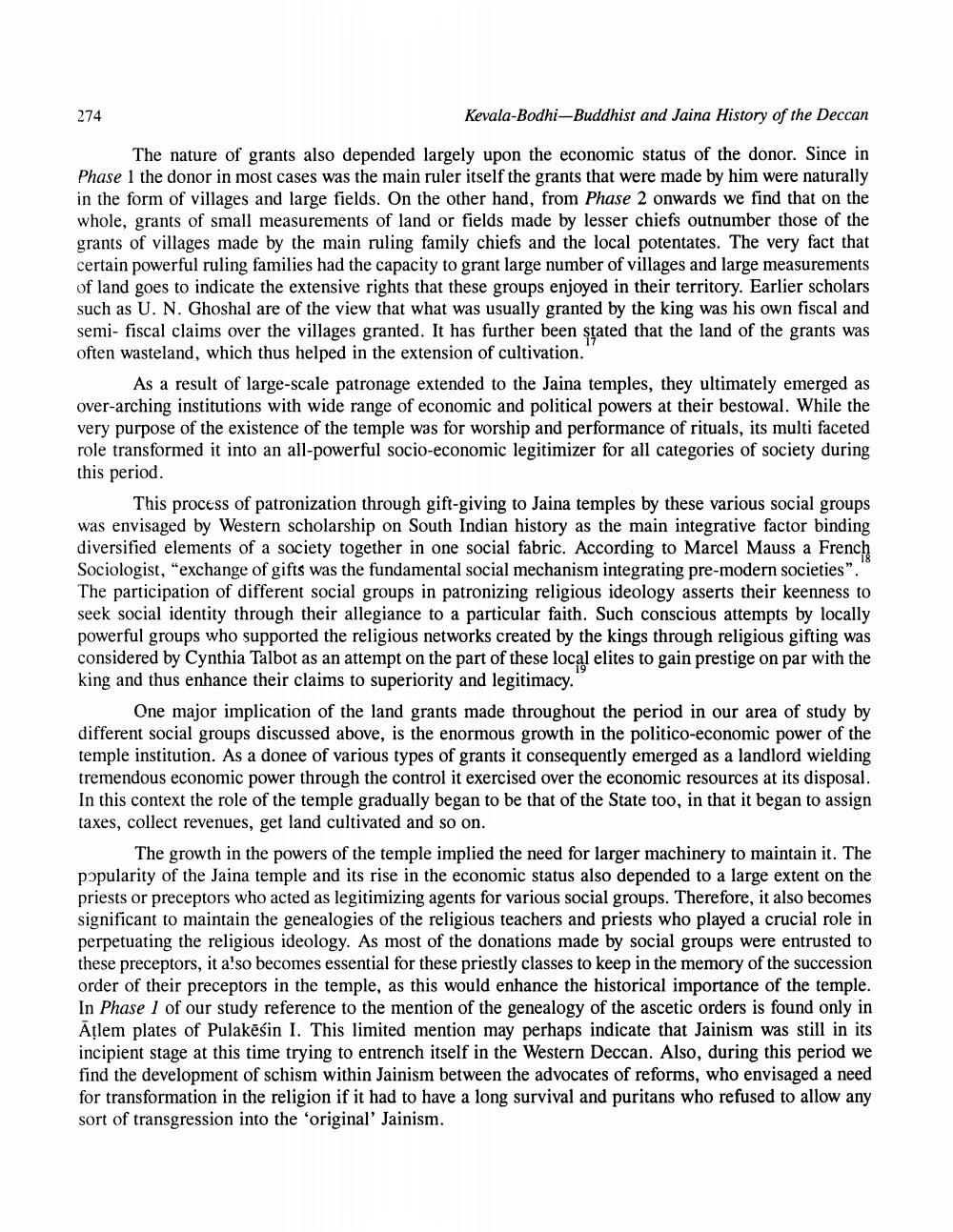________________
274
Kevala-Bodhi--Buddhist and Jaina History of the Deccan
The nature of grants also depended largely upon the economic status of the donor. Since in Phase 1 the donor in most cases was the main ruler itself the grants that were made by him were naturally in the form of villages and large fields. On the other hand, from Phase 2 onwards we find that on the whole, grants of small measurements of land or fields made by lesser chiefs outnumber those of the grants of villages made by the main ruling family chiefs and the local potentates. The very fact that certain powerful ruling families had the capacity to grant large number of villages and large measurements of land goes to indicate the extensive rights that these groups enjoyed in their territory. Earlier scholars such as U. N. Ghoshal are of the view that what was usually granted by the king was his own fiscal and semi- fiscal claims over the villages granted. It has further been stated that the land of the grants was often wasteland, which thus helped in the extension of cultivation.
As a result of large-scale patronage extended to the Jaina temples, they ultimately emerged as over-arching institutions with wide range of economic and political powers at their bestowal. While the very purpose of the existence of the temple was for worship and performance of rituals, its multi faceted role transformed it into an all-powerful socio-economic legitimizer for all categories of society during this period.
This process of patronization through gift-giving to Jaina temples by these various social groups was envisaged by Western scholarship on South Indian history as the main integrative factor binding diversified elements of a society together in one social fabric. According to Marcel Mauss a French Sociologist, "exchange of gifts was the fundamental social mechanism integrating pre-modern societies". The participation of different social groups in patronizing religious ideology asserts their keenness to seek social identity through their allegiance to a particular faith. Such conscious attempts by locally powerful groups who supported the religious networks created by the kings through religious gifting was considered by Cynthia Talbot as an attempt on the part of these local elites to gain prestige on par with the king and thus enhance their claims to superiority and legitimacy.
One major implication of the land grants made throughout the period in our area of study by different social groups discussed above, is the enormous growth in the politico-economic power of the temple institution. As a donee of various types of grants it consequently emerged as a landlord wielding tremendous economic power through the control it exercised over the economic resources at its disposal. In this context the role of the temple gradually began to be that of the State too, in that it began to assign taxes, collect revenues, get land cultivated and so on.
The growth in the powers of the temple implied the need for larger machinery to maintain it. The popularity of the Jaina temple and its rise in the economic status also depended to a large extent on the priests or preceptors who acted as legitimizing agents for various social groups. Therefore, it also becomes significant to maintain the genealogies of the religious teachers and priests who played a crucial role in perpetuating the religious ideology. As most of the donations made by social groups were entrusted to these preceptors, it also becomes essential for these priestly classes to keep in the memory of the succession order of their preceptors in the temple, as this would enhance the historical importance of the temple. In Phase 1 of our study reference to the mention of the genealogy of the ascetic orders is found only in Atlem plates of Pulakēsin I. This limited mention may perhaps indicate that Jainism was still in its incipient stage at this time trying to entrench itself in the Western Deccan. Also, during this period we find the development of schism within Jainism between the advocates of reforms, who envisaged a need for transformation in the religion if it had to have a long survival and puritans who refused to allow any sort of transgression into the ‘original Jainism.




